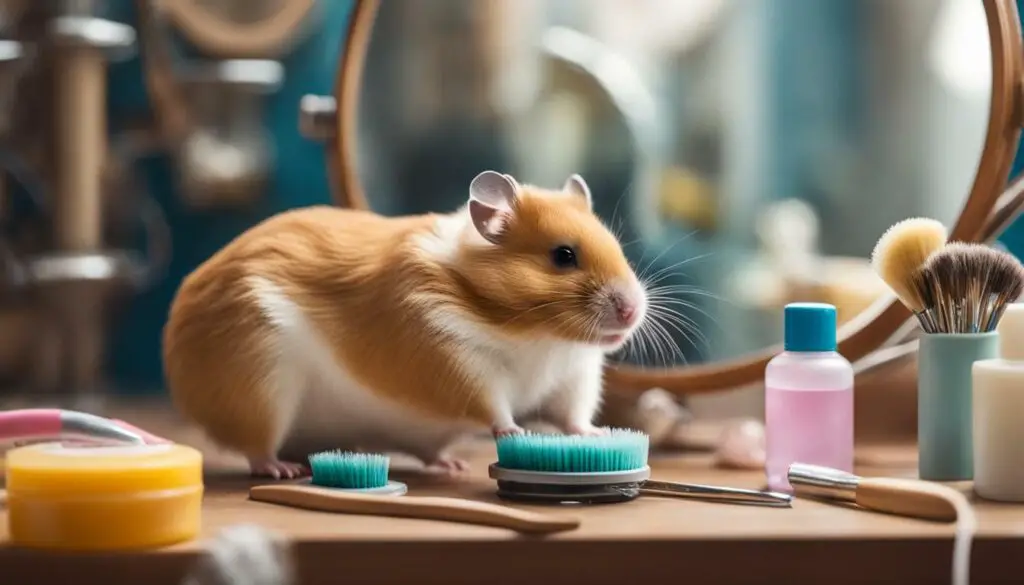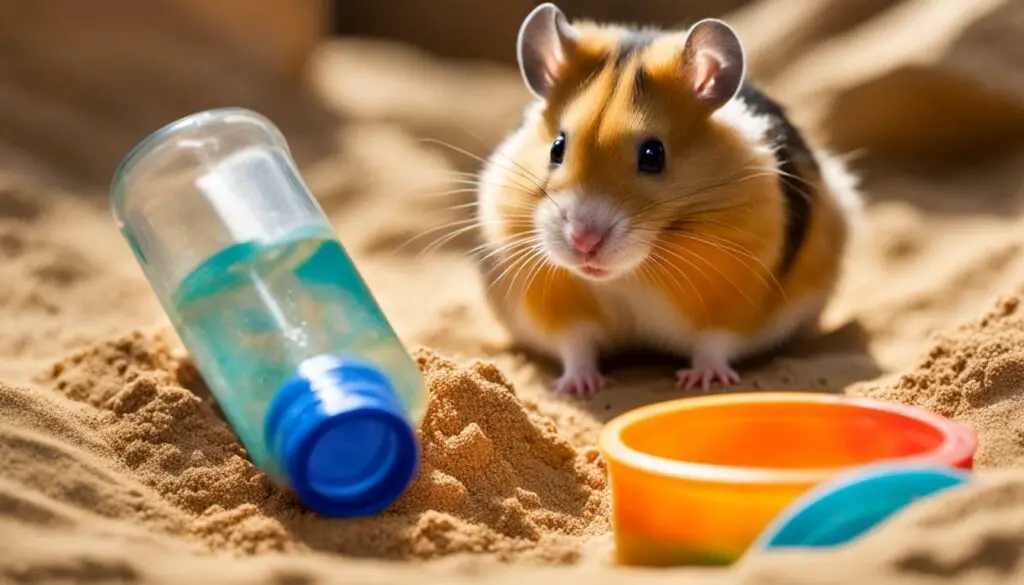Hamsters are known for their grooming habits and have a natural instinct to keep themselves clean. They have scent glands in their hip area and will spread the oils secreted from these glands all over their bodies. This self-grooming process helps to maintain their hygiene and keep their fur in good condition.
Grooming is an essential behavior for hamsters. It not only keeps them clean but also helps to distribute natural oils throughout their fur, keeping it soft and healthy. Hamsters are meticulous self-groomers and spend a significant amount of time each day attending to their personal hygiene needs.
Key Takeaways:
- Hamsters have a natural instinct to keep themselves clean through self-grooming.
- They have scent glands in their hip area that secrete oils for grooming purposes.
- Bathing is not recommended for hamsters as it can remove essential oils and increase the risk of illness.
- Regular cage cleaning is important to prevent odor and maintain a healthy environment for your hamster.
- Hamsters enjoy sand baths, which help to keep their coats clean and should be provided 2-3 times a week.
It’s important to understand and support your hamster’s grooming needs. While they are excellent self-groomers, providing appropriate grooming opportunities and maintaining a clean living environment are essential for their overall well-being. By taking care of their hygiene, you can ensure that your hamster remains happy and healthy.
How Hamsters Maintain Cleanliness
Hamsters maintain their cleanliness through various self-grooming rituals and the secretion of oils from their scent glands. These small furry creatures are meticulous when it comes to keeping themselves tidy. Their natural grooming behavior not only helps them stay clean but also plays a vital role in their overall health and well-being.
One of the primary ways hamsters clean themselves is by using their tongues to lick their fur. They carefully run their tongues all over their bodies, removing dirt, debris, and excess oils. This self-grooming behavior helps to keep their coats in pristine condition and prevents the buildup of harmful substances that could lead to skin problems.
Additionally, hamsters have scent glands located in their hip area. These glands produce oils that hamsters spread throughout their fur during grooming. This not only helps to keep their coats soft and shiny but also serves as a form of communication. The scent from these glands acts as a natural marker, allowing hamsters to establish their territory and recognize familiar scents.
To assist hamsters in their grooming routine, you can provide them with suitable tools and materials. A soft toothbrush can be used to gently brush out any tangles or remove objects stuck in their fur. However, it’s important to be gentle and never force anything out, as hamster skin is delicate. Avoid using water to bathe hamsters, as it can strip away essential oils and disrupt their natural balance.

| Grooming Tips for Hamsters: |
|---|
| Provide chinchilla sand or hamster-specific sand for regular sand baths, which help in removing excess oils and maintaining a clean coat. |
| Ensure your hamster’s cage is cleaned regularly to prevent odor and maintain a hygienic environment. |
| Observe your hamster’s grooming habits and appearance. A sudden change in grooming behavior or a smelly hamster could indicate an underlying health problem that requires veterinary attention. |
In conclusion, hamsters are excellent self-groomers, taking pride in their cleanliness. By understanding and supporting their natural grooming behavior, you can help ensure that your furry friend stays healthy and happy.
Grooming Needs of Hamsters
Meeting the grooming needs of hamsters is crucial for their overall health and well-being. These small furry creatures are excellent self-groomers, but they may still need a little assistance in maintaining their cleanliness. Hamsters have a natural grooming ritual that involves using their paws and tongue to clean themselves. They meticulously groom their fur, removing dirt, debris, and excess oil.
Hamsters also have scent glands located in their hip area, which secrete oils that help condition their fur and mark their territory. These oils are then spread all over their bodies during grooming. This natural self-grooming behavior not only keeps their coats clean but also helps to regulate body temperature and maintain proper skin health.
However, despite their grooming abilities, hamsters may occasionally require some additional care. If you notice something stuck in your hamster’s fur, it’s best to gently brush it out with a soft toothbrush to prevent any discomfort or matting. It’s essential to be gentle and avoid causing any stress to your furry friend during this process.
Regular cleaning of the hamster’s cage is also crucial for maintaining cleanliness. Hamster cages should be cleaned at least once a week to remove waste, soiled bedding, and any potential odor. A clean and odor-free environment is not only more pleasant for both you and your hamster but also essential for their health. Persistent or strong odors could indicate a health problem, and it’s advised to consult a veterinarian if you notice any unusual smells or changes in your hamster’s behavior.
The following table summarizes the grooming needs of hamsters:
| Grooming Needs | Importance |
|---|---|
| Self-grooming | Keeps the coat clean, regulates body temperature, and maintains skin health. |
| Brushing | Helps remove any stuck debris and prevents fur matting. |
| Cage cleaning | Prevents odor buildup and maintains a hygienic environment for the hamster. |
Another grooming activity that hamsters enjoy is a sand bath. Providing a sand bath two to three times a week using hamster-specific sand or chinchilla sand allows them to roll around in the sand, which helps remove excess oils and keeps their coats clean. Gently patting your hamster’s fur afterward with a dry cloth can help remove any remaining sand particles.
In conclusion, while hamsters are skilled self-groomers, it’s important to provide them with proper grooming opportunities and maintain a clean environment. By meeting their grooming needs, you ensure that your furry friend stays healthy, comfortable, and happy.

While bathing is not recommended for hamsters, there are gentle brushing techniques that can help remove any debris from their fur. Hamsters are excellent self-groomers and can typically keep themselves clean by using their paws and tongues. However, if your hamster gets something stuck in its fur, like a piece of food or bedding, you can use a soft toothbrush to gently brush it out. Be careful not to pull or tug on the fur, as hamsters have delicate skin.
Brushing your hamster not only helps to keep their fur clean but also strengthens the bond between you and your pet. It can be a calming and enjoyable experience for both of you. Choose a soft-bristled toothbrush specifically designed for small animals, and always brush in the direction of their fur growth. Start from the head and work your way down, using gentle strokes. Take your time and be patient, allowing your hamster to relax and get used to the sensation.

Regular cage cleaning is also essential for maintaining cleanliness in hamsters. A dirty cage can lead to unpleasant odors and increased risk of illness. Remove any soiled bedding or droppings daily, and deep clean the cage once a week. Use a mild, pet-safe detergent and rinse thoroughly to ensure no residue is left behind. Provide fresh bedding and ensure that the cage is dry before returning your hamster to their habitat.
In addition to brushing and cage cleaning, hamsters enjoy sand baths as part of their grooming routine. A sand bath helps to remove excess oils from their fur and keeps them clean. Use a shallow bowl or a designated sand bath container and fill it with hamster-specific sand or chinchilla sand. Place the container in the cage two to three times a week and allow your hamster to roll around and groom themselves in the sand. Remove the sand bath after 10-15 minutes to prevent it from becoming soiled.
Table: Hamster Grooming Techniques
| Technique | Benefits |
|---|---|
| Self-grooming | Keeps fur clean and healthy |
| Gentle brushing | Removes debris from fur and strengthens bond |
| Cage cleaning | Prevents odors and reduces risk of illness |
| Sand baths | Removes excess oils and promotes grooming |
Cage Cleaning and Odor Control
Keeping the hamster’s cage clean is essential for their hygiene and overall health. Regular cleaning not only prevents unpleasant odors but also creates a clean and comfortable living environment for your furry friend. A smelly cage can indicate a health problem, so it’s important to address any odors promptly. Here are some tips to maintain a fresh and odor-free hamster cage:
- Start by removing any uneaten food, soiled bedding, and droppings daily. This will help prevent the buildup of odor-causing bacteria.
- Change the bedding completely every one to two weeks, depending on the size of the cage and the number of hamsters. Fresh bedding will help absorb odors and keep the cage clean.
- Wash the cage accessories, such as the water bottle, food bowl, and wheel, on a regular basis. Use a mild detergent and rinse thoroughly to remove any residue.
- Disinfect the cage every month to ensure it is free from harmful bacteria. Use a hamster-safe disinfectant or a mixture of vinegar and water. After disinfecting, rinse the cage thoroughly and allow it to dry completely before placing the hamster back inside.
Remember, hamsters are sensitive to strong smells and chemicals, so avoid using harsh cleaning products or aerosols near their cage. Opt for hamster-safe cleaning solutions to ensure the health and well-being of your furry companion.
Complete Cage Cleaning Schedule
| Task | Frequency |
|---|---|
| Remove uneaten food, soiled bedding, and droppings | Daily |
| Change bedding completely | Every 1-2 weeks |
| Wash cage accessories | Regularly |
| Disinfect the cage | Every month |

Sand Baths for Hamsters
Sand baths play a vital role in helping hamsters keep their coats clean and healthy. Hamsters are meticulous groomers by nature, using their paws and tongues to remove dirt and excess oils from their fur. However, sometimes they need a little extra help to maintain their cleanliness. This is where sand baths come in.
A sand bath provides a natural and enjoyable way for hamsters to groom themselves. The texture of the sand helps to remove dirt and grease from their fur, leaving it fresh and shiny. It also helps to prevent matting and tangling, which can lead to discomfort and skin problems. By rolling and digging in the sand, hamsters are able to reach areas that are difficult to clean with their tongues alone.
To offer your hamster a sand bath, you will need hamster-specific or chinchilla sand. These types of sand are specifically formulated to be safe for hamsters and free from harmful additives. Place a shallow dish or container filled with sand in your hamster’s cage, making sure it is easily accessible. It’s recommended to provide a sand bath two to three times a week, allowing your hamster to indulge in their natural grooming behavior.

Table: Comparison of Different Types of Sand for Hamsters
| Type of Sand | Features | Recommended Frequency |
|---|---|---|
| Hamster-Specific Sand | Dust-free, suitable for sensitive hamster respiratory systems | 2-3 times a week |
| Chinchilla Sand | Coarser texture, helps with nail filing | 2-3 times a week |
| Children’s Play Sand | Not recommended, may contain harmful chemicals or dust | Not suitable for hamsters |
“Sand baths are not only a way for hamsters to stay clean, but they also provide mental and physical stimulation. It’s a natural behavior for them to burrow and dig, and a sand bath allows them to satisfy these instincts while maintaining their hygiene.” – Dr. Jane Johnson, Veterinarian
While hamsters are generally good self-groomers, they may need some human assistance to ensure their cleanliness. Regularly providing sand baths, along with a clean and odor-free cage, is essential for their well-being. Sand baths not only promote good hygiene but also provide enrichment and enjoyment for your furry friend. So, go ahead and give your hamster the spa treatment they deserve!
Conclusion
Taking care of a hamster’s grooming needs is crucial for their overall health and well-being. Hamsters are natural self-groomers, spreading the oils from their scent glands all over their bodies to maintain cleanliness. Bathing is not recommended for hamsters as it can remove these essential oils and increase the risk of illness. However, if your hamster has something stuck in its fur, you can gently brush it out with a soft toothbrush to help them stay clean.
Regular cage cleaning is also important to prevent unpleasant odors and maintain a clean environment for your hamster. A smelly hamster could indicate a health problem, so if you notice any persistent odor, it’s best to consult a veterinarian. Keeping the cage clean not only benefits your hamster’s hygiene but also contributes to their overall well-being.
In addition to self-grooming and cage cleaning, hamsters enjoy sand baths. Sand baths help to keep their coats clean and provide mental stimulation. It is recommended to provide a sand bath two to three times a week using hamster-specific sand or chinchilla sand. This allows your hamster to indulge in their natural grooming behavior and helps them maintain their cleanliness.
Overall, while hamsters are good self-groomers, they may occasionally need some assistance in maintaining their hygiene. By providing suitable grooming opportunities, keeping their cage clean, and allowing them to enjoy sand baths, you can ensure that your hamster stays clean, healthy, and happy.
FAQ
Do hamsters groom themselves?
Yes, hamsters are good self-groomers. They have scent glands in their hip area and spread the oils secreted from these glands all over their bodies to keep themselves clean.
Is bathing recommended for hamsters?
No, bathing is not recommended for hamsters. It can remove essential oils and increase the risk of illness. Hamsters are capable of keeping themselves clean through grooming.
What should I do if my hamster has something stuck in its fur?
If your hamster has something stuck in its fur, it can be gently brushed out with a soft toothbrush. Make sure to be gentle and careful to not hurt the hamster.
How often should I clean my hamster’s cage?
Hamster cages should be cleaned regularly to prevent odor and maintain hygiene. Aim to clean the cage at least once a week, removing any soiled bedding and food waste.
My hamster smells bad, what could be the cause?
If your hamster smells bad, it could indicate a health problem. Odor can be a sign of illness, so it’s important to monitor your hamster’s overall health and behavior. If in doubt, consult a veterinarian.
Do hamsters enjoy sand baths?
Yes, hamsters enjoy sand baths. Sand baths help to keep their coats clean and healthy. Provide a hamster-specific or chinchilla sand and offer a sand bath two to three times a week.
Can I use regular sand for a hamster’s sand bath?
It is recommended to use hamster-specific or chinchilla sand for a hamster’s sand bath. Regular sand may contain additives or be too coarse for their sensitive skin.
Do hamsters need any assistance in maintaining their cleanliness?
Hamsters are generally good at self-grooming, but they may need some assistance in maintaining their cleanliness. Regular cage cleaning and providing appropriate grooming opportunities, such as sand baths, can help promote their hygiene.




